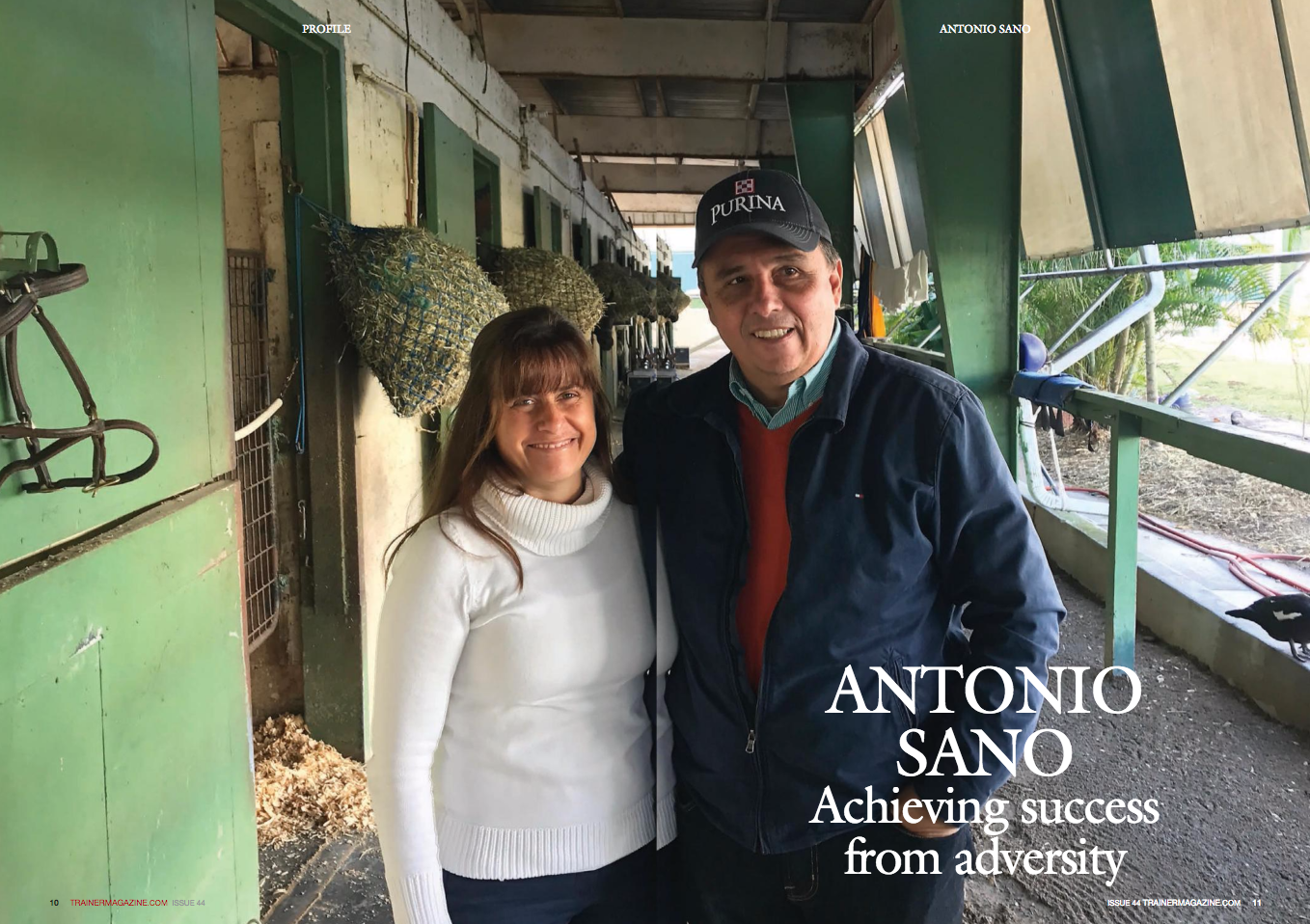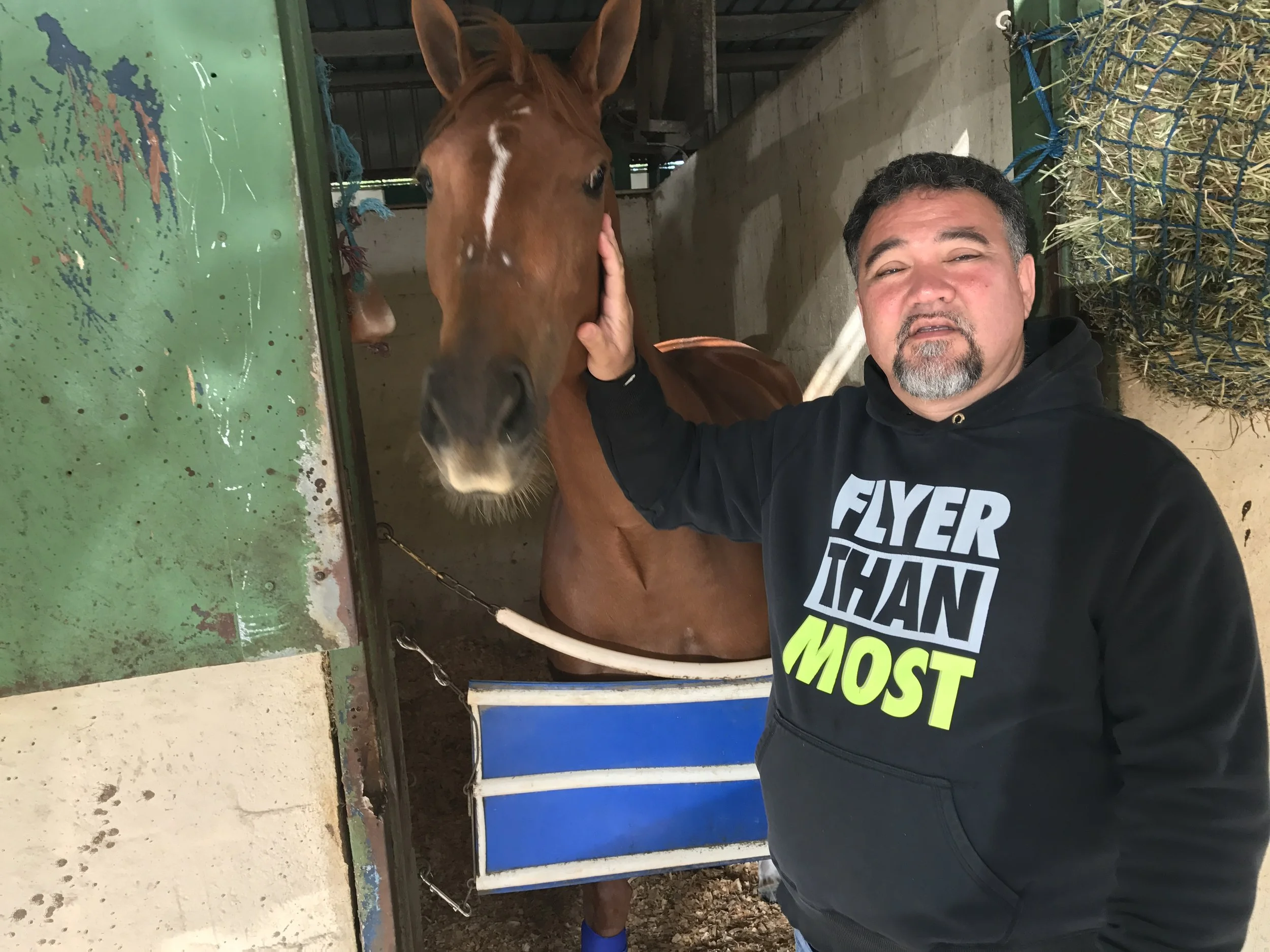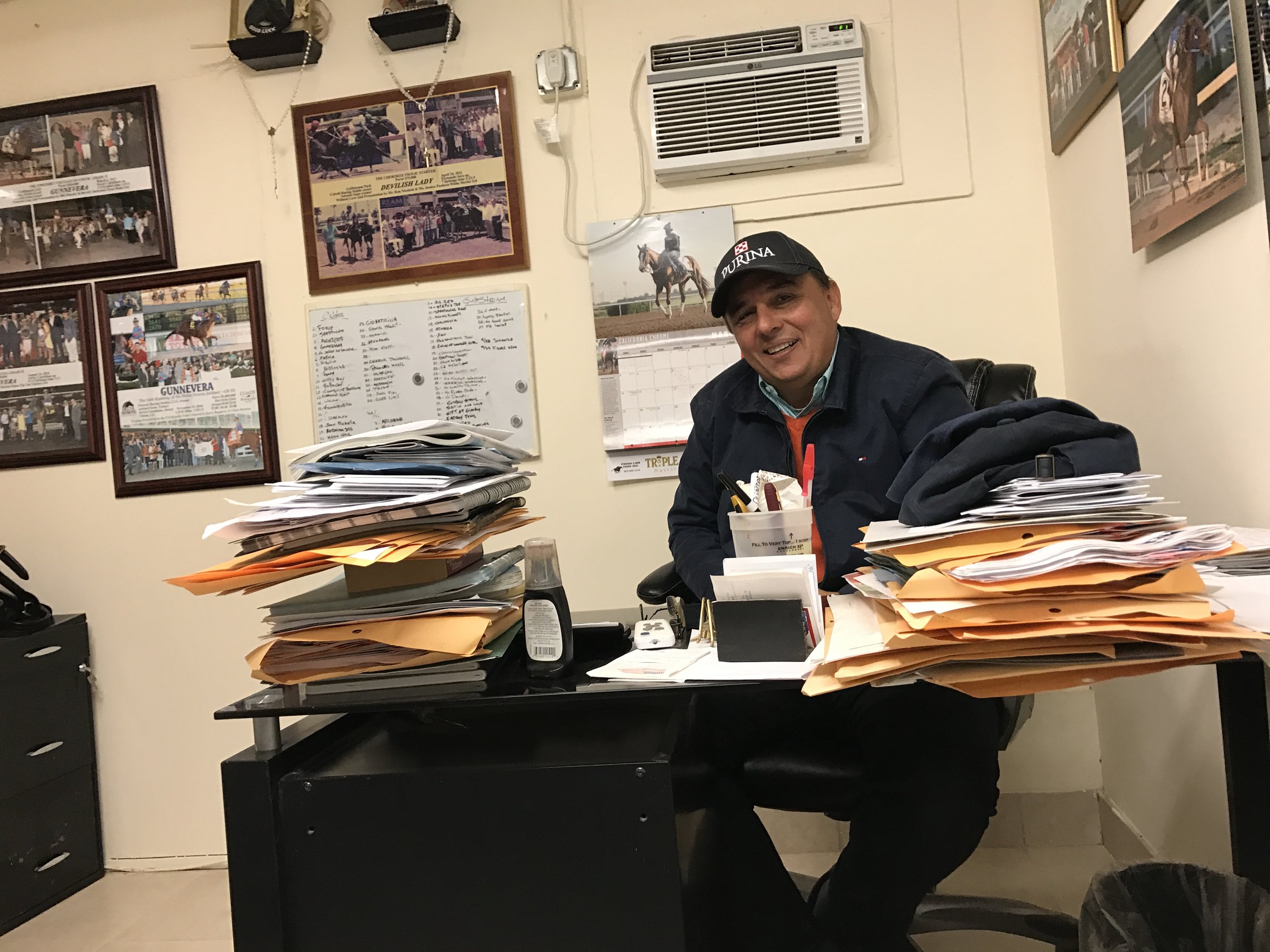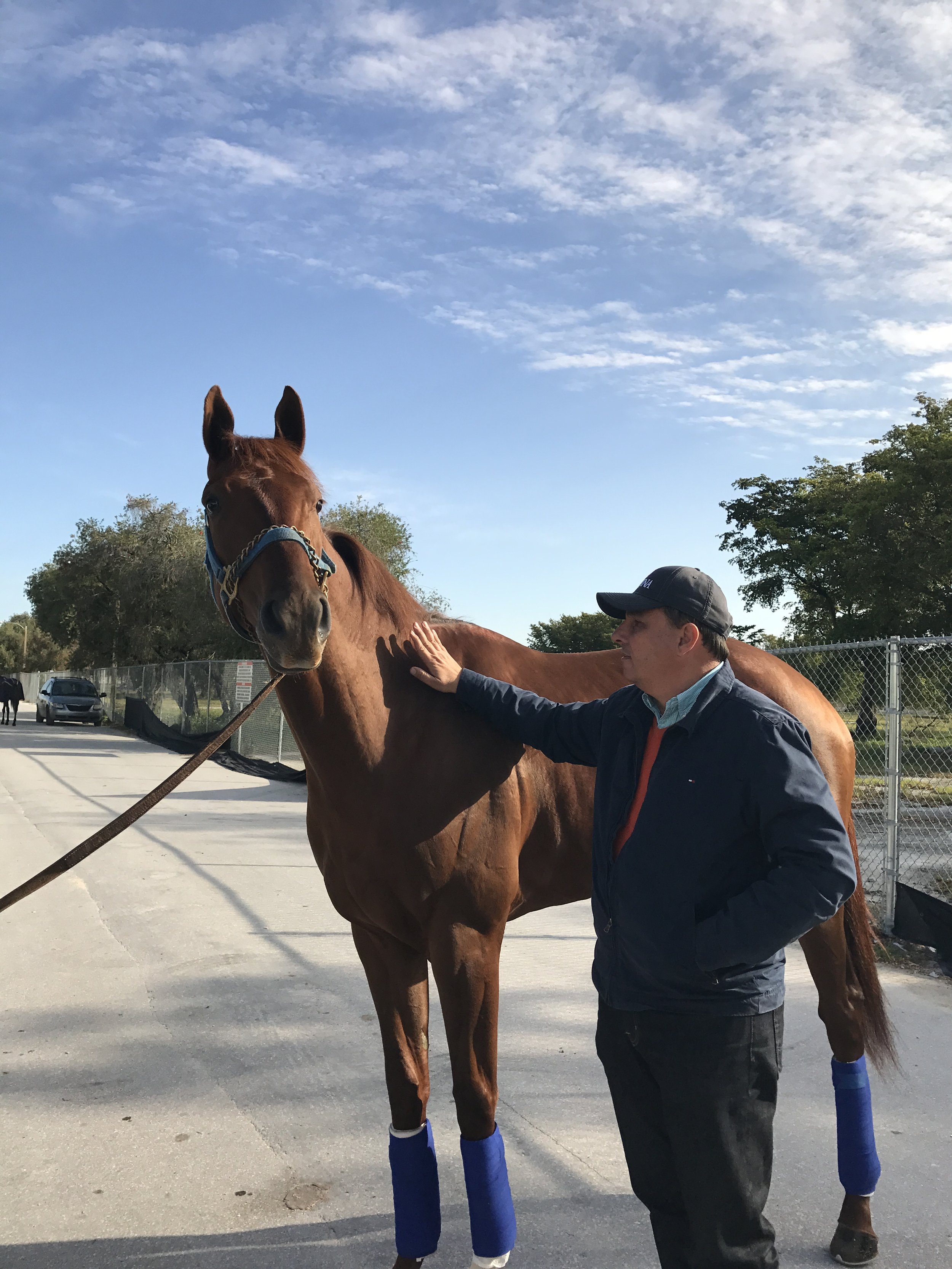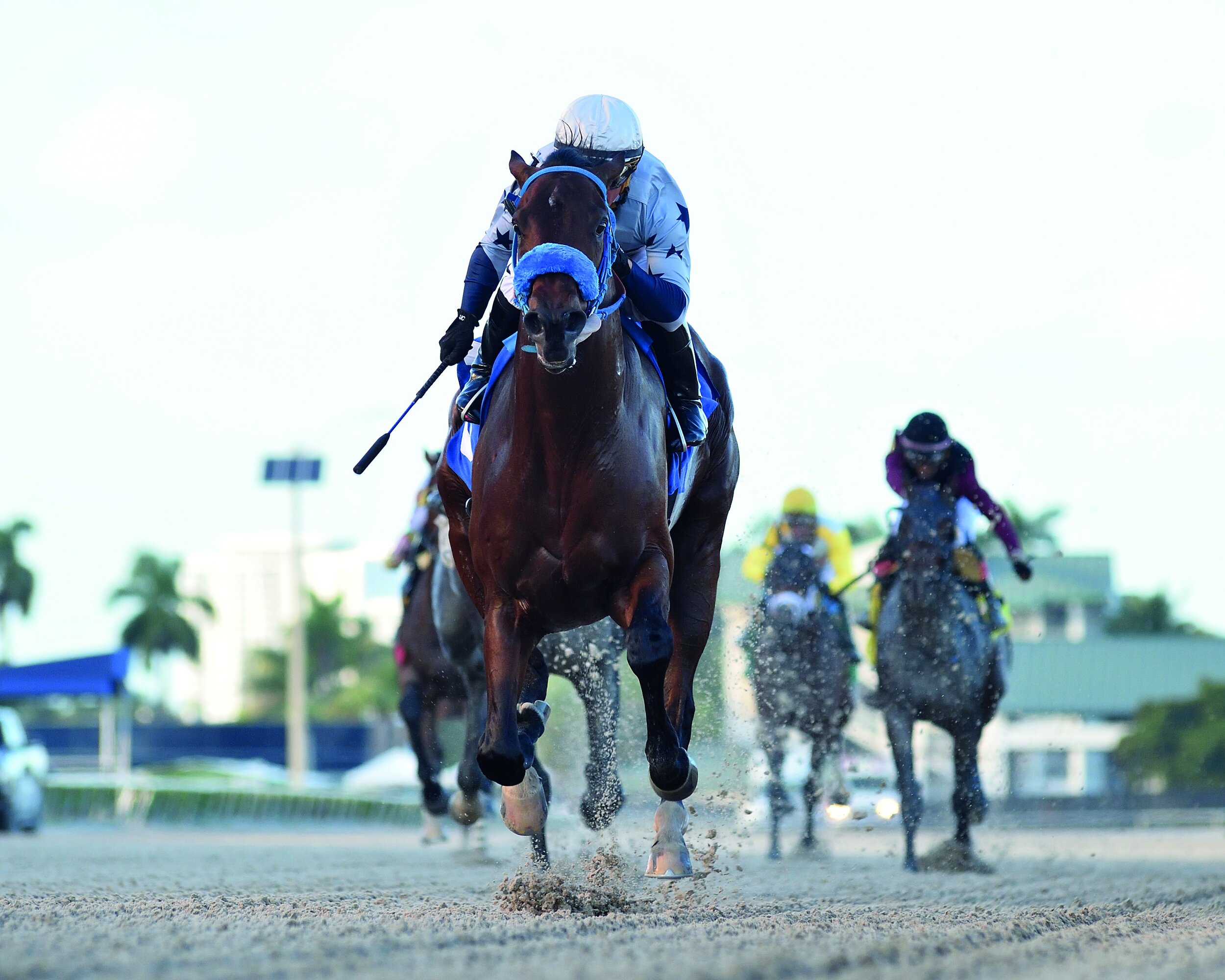Antonio Sano trainer of Preakness contender - Simplification
This article was first published ahead of the 2017 Kentucky Derby - when Calder was still open for training.
We’re republishing it ahead of the 2022 Preakness Stakes - where Sano will start Simplification for owner Tami Bobo.
————————————————————————————————-
Antonio Sano is an early riser and according to his wife Maria Christina, not the greatest of sleepers in any instance. Up at 3:50 every morning come rain or shine, Sano can be found splitting time between his barns at Calder and Gulfstream Park. Between the two locations, he’s got roughly 70 horses in his care.
Assistant trainer Jesus “Chino” Prada
The two- and three-year-old are based at Calder, and the older horses are some 10 miles away at Gulfstream. “I like the track [at Calder] for the babies. It’s a good track, deep sand, and when it rains it drains, while over at the other place, it can take two days to clear.” Assistant trainer Jesus “Chino” Prada, who has been an integral member of the team since Sano started training in the U.S., chips in: “Gulfstream is great for racing, but here is the best for training.”
Sano might not yet be a household name across North America, but in his native Venezuela, the man’s a legend. He trained no less than 3,338 winners on his home soil, and it was only thanks to a kidnapping in 2009 that lasted longer than a month that he quit training in the country. The kidnapping -- his second -- resulted in the father-of-three doing what was best for his family, which was to remove them from the danger that his success was creating.
Sano is a third-generation trainer. “My father, grandfather, and uncle all worked with horses,” he recounts. “My father right now is 88 years old. He arrived from Italy when he was just 16 and was working with horses. They came from Sicily. In fact, my whole family is from there, including my wife!”
After graduating from college with a degree in engineering, the magnetic pull to the racetrack was too great, and Sano went to work as an assistant trainer Julio Ayala to enhance what knowledge and skills had been passed down to him from his father and grandfather.
Eventually (March, 1988) setting up on his own, Sano ended up training in Venezuela for 23 years, earning the trainers’ championship title 19 times and winning an average of 150 races annually, with three year-end win tallies in excess of 200. That’s no mean feat when you consider that racing only takes place twice a week in the major city of Valencia, where Sano was based.
In Venezuela, according to Sano, the pedigrees of the horses he trained were a little different than what he works with in the U.S., and so was the daily training regime. “I had 160 horses in my barn and worked the horses in four groups. Riders here take the horses to the track every 45 minutes and come back. There 4 sets of 40 horses each. Every rider work on 2 horses per set. I had the privilege to count with 20 riders at that time. We would take them all to the track at 6 A.M. At 6:45 A.M., the second set would be ready, the third by 7:30 A.M., and the last before 8:30 A.M.”
After first going from Venezuela to Italy, Sano and his family moved to the U.S. in March of 2010. They had visited the country before without spending any time at the racetrack, preferring the great vacationing opportunities that Florida offers with a young family in tow.
Well known for his training of staying types, Sano found the transition to training the speed-bred horses of the U.S. “Each horse is different, but I’ve learned more from others around me here in the U.S. than I ever learned in Venezuela,” he says -- modest words, perhaps, for a trainer who is a master of his game. “But my focus is always on the way the horses finish.”
Prada has been a friend of Sano’s for over 40 years. They attended trainer school together, along with Enrique Torres.
Their teaming up in Florida may never have happened had Sano decided to move to Italy after the kidnapping. “Italy has beautiful people and great food, but the racing wasn’t for me. So I went to Florida and met Mike Antifantis (the racing secretary at Calder at the time), who gave me a couple of stalls. I then had to go back to Venezuela and close shop, giving all my horses away.”
March 22, 2010, was an important date in Sano’s and Prada’s lives. It marked the start of a new chapter, when they claimed their first horse for their fledgling operation. The numbers quickly grew from there. “Two horses became four, and quickly we had 10,” recounts Prada.
The stable ended its first season with 37 winners, including two in stakes races. Knowing very few people or being known to few was probably a good thing for Sano as he and Prada quietly went about building their business. And where resentment for the new man in town could have quickly grown, friendships flourished with other trainers. “They treated me well and with respect,” says Sano.
With a successful formula in place, Sano’s stable was able to gradually improve the quality of stock. Still, his patronage remains primarily from Venezuelan or other Latin American ownership interests; he hasn’t really caught on with American owners.
In 2004, Sano started to shift his focus away from claiming horses to buying yearlings, while still using the claiming philosophy of trading up purchases. This time last year, Sano had high hopes for a then-unraced Broken Vow filly named Amapola, who he had bought as a yearling for $25,000. Amapola crossed the wire first by nearly 10 lengths in her May, 2016, debut in track record time for four-and-a-half furlongs at Gulfstream, only to lose the race in the stewards room for drifting in at the start. She turned a lot of heads that day, and Sano parted with her for a substantial profit. “I sold her for the money,” he says.
As with most buyers at sales, pedigree and conformation are at the top of Sano’s list when studying a catalogue page, but for him the stride of the individual and the horse’s eye are the main factors to determine if he is going to raise his hand in the ring -- should the price fall in his preferred buying range of $5,000 to $50,000.
In 2015, Sano made a number of purchases at yearling sales, and came home from the Keeneland September sale with a good-looking son of first crop sire and Florida Derby winner Dialed In.
The sale of that colt, from the consignment of Jim and Pam Robinson’s Brandywine Farm, must have been a rather bittersweet moment for breeders Brandywine and Stephen Upchurch. The chestnut’s dam Unbridled Rage had died about a week and a half after he was born, and the newly orphaned foal was bottle-fed until a foster mare could be found.
Sano with Gunnevera
That colt, for which Sano had the winning bid at $16,000, was, of course, Gunnevera. And thanks to him, if Dialed In hadn’t already been a particular favorite of Sano’s, he certainly would be now.
After the sale at Keeneland, Gunnevera, along with the other Sano purchases, was sent to Classic Mile Park in Ocala, where he was broken by Julio Rada a classmate of Sano and Prada’s at the Venezuelan training school in 1988.
Gunnevera was showing potential at Classic Mile and by the time of his arrival at Calder, his reputation was growing. However, the faith shown in him by those who knew him best wasn’t being shared by everyone: the first-time owner who Sano had bought the horse for eventually got around to paying for the colt...but the check bounced.
The name “Gunnevera” has no real meaning. It’s a combination of place names and words favored by his ownership interests -- Jamie Diaz, originally from Spain but now in Miami; and Peacock Racing, a partnership of Venezuelans Guillermo Guerra and Guerra’s father-in-law Solomon Del-Valle, who ended up with the horse just six weeks before his first run.
Del-Valle’s friendship with Sano is deeper than most normal friendships, as it was he who helped Sano’s wife arrange and finance Sano’s release from his kidnappers. “I told him that we bought horses at the yearling sale and this was the best one, that I’m going to make him a champion.” Sano’s prophecy looks like it’s showing some promise, and Gunnevera’s success has gone someway toward repaying Del-Valle’s generosity to the Sano family over the years.
————————————————————————————————-
Fast forward to 2022 and Gunnevera stands as a stallion at Pleaseant Acres Stallions in Morriston, FL. He has earned his place in the stallion barn on the back of his race record - winning the Grade 2 Saratoga Special and the Grade 3 Delta Downs Jackpot at two. At three he won the Grade 2 Fountain of Youth, finished second in both the Grade 2 Holy Bull and the Grade 1 Travers and was a game third in the Grade 1 Florida Derby.
As a four year old he finished second in a pair of Grade 1’s - The Breeders’ Cup Classic and the Woodward Stakes and ran a gallant third in the Pegasus World Cup (Gr.1). At five, his third place finish in the Dubai World Cup (Gr.1) meant that he retired with earnings of over $5.5m and as such has become the highest ever earner to stand at stud in Florida.
Gunnevera was not his trainer’s first graded stakes winner; although none received anywhere near the level of acclaim as the son of Dialed In. Sano previously handled Devilish Lady, City of Weston, and Grand Tito to graded stakes wins.
Sano is the first to admit that nothing has compared to the Gunnevera success story and the national exposure he received. But how well does he react to the inevitable pressure? “I’ve never been in a situation like this before, but it’s a blessing,” he calmly says. For Maria Christina, it’s as if her husband’s life is going on just the same. “He never sleeps before any race, he’s always thinking about something.”
Come to think of it, Sano’s whole day and night seems to be taken up with work or thinking about horses. The work day often ends 16 hours after it began, giving Sano a little much-needed family time with his three children. His eldest son Alessandro is already following in the family business and now works as one of his father’s assistant trainers.
But what about time away from horses, does Sano take a vacation? “One week -- and I don’t relax,” he says. “He’s always on the phone to Chino and I say, ‘No phone, Tony, the horses won’t run faster with you not there,’” interjects Maria Christina.
“Twenty (five) years ago when Alessandro was born, I would never have thought that I would be where I am now,” says Sano.
“But Tony, you were scared to come here 20 years ago. There wasn't the opportunity we have here in Venezuela,” retorts Maria Christina.
So Venezuela’s loss is America’s gain, and this is one family truly living the American dream.
First published in North American Trainer issue 44 - May - July 2017
Buy this back issue here!
Preakness Stakes - Owner Profile - Tami Bobo - Simplification
By Bill Heller
Having loved, ridden and worked with horses for 46 of her 48 years, and having dealt with Arabians, Quarter Horses and Thoroughbreds, you’d think Tami Bobo would have picked up all the equine knowledge she’ll ever need. Wrong.
Asked if she is still learning, Tami said, “One hundred percent, if you just watch them. I learn every day from horses. I love to learn, so I enjoy it. Most recently, I’ve been learning about this industry. It’s fascinating. Not being born into it, I wasn’t exposed to people approaching you wanting to buy your horses.”
The most inquiries have been about one horse, Simplification, who will take Tami and Simplification’s trainer, Antonio Sano, to the Preakness Stakes off a solid dirt record of three victories, one second, two thirds and a fourth placed finish last time out in the Kentucky Derby. “My hat’s off to Antonio, managing a staff, trying to execute a plan,” Tami said. “Most recently, my learning is how to manage a Kentucky Derby contender.”
Now the learning journey moves on to Baltimore where Simplification will break from the #1 hole in the 2022 Preakness Stakes.
She may not have been born into horse racing, but she didn’t miss by much. “I have pictures of me on a horse when I was less than two-years-old,” she said. “My family moved to Ocala when I was eight years old. I showed horses all over the country.”
Working at one point as a single mother, she had to hustle to make a living with horses. “Quarter Horses were keeping me whole,” she said. “I was teaching riding lessons and pinhooking Quarter Horses. I did very well pinhooking, but the profit with Quarter Horses is small. It kept food on the table.”
Asked how she has dealt with different breeds, she said, “I think at the end of the day, it’s horsemanship. You are either a horseman or you’re not. If you know horses and pay attention, they will tell you what they need. Then you address any issues. There’s an idea that horses aren’t intelligent. It’s a misconception. Horses are extremely intelligent. They have to have intelligence and the mindset to race.”
Simplification, jockey Javier Castellano, and Tami Bobo celebrate after winning the Mucho Macho Man Stakes at Gulfstream Park, 2022
In 2010, Bobo switched from Quarter Horses to Thoroughbreds and is still enjoying the wisdom of that decision. And the first Thoroughbred she bought was Take Charge Indy, a phenomenally bred colt by A.P. Indy out of multiple graded-stakes winner Take Charge Lady, whose victories included the Gr. 1 Ashland and Spinster Stakes.
Take Charge Indy was entered in the 2010 Keeneland September Yearling Sale, but failed to reach the $80,000 reserve price because of a conformation issue and a short stride. Bobo saw a great opportunity and took it, believing the colt could overcome his deficiencies over time.
And that’s exactly what he did under the astute handling of trainer Patrick Byrne. Take Charge Indy won the Gr. 1 Florida Derby by a length under Calvin Borel. That earned a spot in the starting gate for the Kentucky Derby, but Take Charge Indy couldn’t keep up, finishing 19th of 20 by 50 lengths.
Borel originally believed the horse had bled, but veterinarians discovered he had chipped a bone in his left front ankle. He underwent surgery and during his recovery was sold to WinStar Farm and Chuck and Maribeth Sandford.
He then finished third in the Gr. 2 Fayette, second by a length in the Gr. 1 Clark Handicap, third in the Gr. 1 Donn Handicap, and second in the Gr. 3 Skip Away Stakes before winning the Gr. 2 Alysheba Stakes by six lengths under Rosie Napravnik.
Simplification will take Tami Bobo and trainer Antonio Sano to the Kentucky Derby off a solid dirt record of 3 victories, 1 second and 2 thirds in 6 starts
For his career, he had three wins, four seconds and two thirds from 14 starts with earnings topping $1.1 million. He has also proven to be a good stallion, standing for $12,5000 at WinStar Farm in 2022 after having sired 586 winners with earnings of just under $19 million. Not a bad racing/stud career for a yearling that nobody but Tami wanted.
Six years ago, Tami and her husband Fernando De Jesus purchased Plumley Farm in Ocala and renamed it First Finds. “We have a weanling, yearlings and pinhooking operation,” Tami said. “We do an average of about 20 pinhooks every year. We do small numbers, so we’re hands-on every day.”
Of course they are. They’re still learning.

